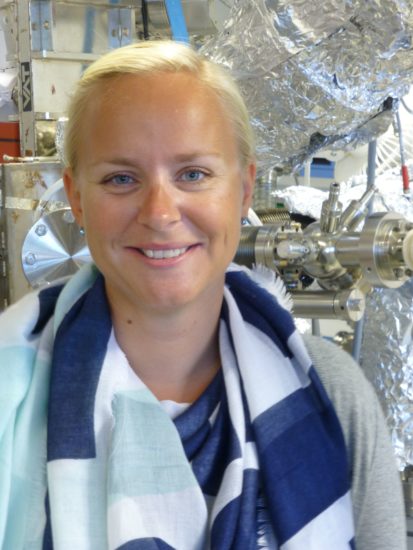 Moni Blum has been coming to the ALS since she was a young graduate student. She’s now an assistant research professor at the University of Nevada, Las Vegas (UNLV) in Clemens Heske’s group and oversees their synchrotron activities at the ALS. The group uses ALS Beamlines 8.0.1 and 9.3.1 to study materials for energy conversion (e.g., thin-film solar cells and materials for solar water splitting). Blum also serves as chair of the ALS Users’ Executive Committee (UEC).
Moni Blum has been coming to the ALS since she was a young graduate student. She’s now an assistant research professor at the University of Nevada, Las Vegas (UNLV) in Clemens Heske’s group and oversees their synchrotron activities at the ALS. The group uses ALS Beamlines 8.0.1 and 9.3.1 to study materials for energy conversion (e.g., thin-film solar cells and materials for solar water splitting). Blum also serves as chair of the ALS Users’ Executive Committee (UEC).
How did you end up at the ALS?
I first came to the ALS as a user in 2005. I had no idea what to expect. To avoid any jetlag problems, I was scheduled for night shift right away, joining in on x-ray emission experiments on solar cell materials. During my PhD program, I came here from Germany every few months to do experiments. I designed and built an endstation (lovingly called “SALSA”) that we are still using today. When I was younger, my goal had always been to work in industry. So, after completing my PhD and a postdoc, I went to work for SPECS in Germany. But I missed research and was drawn back in through a position that opened up at UNLV. I had maintained close contact with Clemens and his group there over the years and was really excited about the opportunity. I’m now a visiting scholar at the ALS, managing the synchrotron activities of the UNLV group here.
What’s the focus of your day-to-day work here at the ALS?
I coordinate all of our group’s experiments. I’m kind of like their own little beamline scientist. Groups with an Approved Program are expected to contribute to the ALS; in this case, one of their contributions is me. I’m around a lot and have my own stock of UNLV parts and tools, so I can provide technical help when needed. If anyone needs something I’m happy to help. I feel very integrated and I feel like a part of the ALS, in addition to being a part of UNLV and its Department of Chemistry and Biochemistry.
What is the focus of your research at the ALS?
I study materials for renewable energy—for example thin-film solar cells and materials for solar water splitting. My goal is to improve in situ and operando measurements, so the endstation we have is dedicated to those techniques. I work on making these experiments more accessible and easier, in particular by developing in situ set-ups. In situ and operando studies are challenging—to get good measurements and avoid pitfalls, it can take multiple generations of set-ups to get there. I use x-ray emission, x-ray absorption, and RIXS at 8.0.1 and 9.3.1. I also use ambient-pressure XPS. These techniques together can answer a lot of questions. Right now we’re focusing on corrosion behavior of materials for photoelectrochemistry, as the most efficient of them are unstable over time. We are answering real-life questions—a lot of the samples we’re working with come from collaborators at other universities and national labs who want specific questions answered about their materials.
How did you get involved with the UEC?
Often when I do something I want to do it with all I have, to give something back. So when I was asked about running for the UEC in 2015 I thought I should go for it. I think the UEC is still often not clear to users—what it does and how it can help users. Having more communication with management through my UEC role has been really interesting—it has helped me understand more deeply how the ALS works.
What do you enjoy most about being at the ALS?
The ALS has always been such a welcoming place. Everyone is working as a team, trying to make a good contribution to science and willing to collaborate and help others in that pursuit. It’s not an “elbow society,” with that sort of extreme competition.
How did you get into this field? Have you always been interested in science?
As a young child I drove my parents crazy; I was always taking things apart—the vacuum cleaner, power outlets. So I’ve always been interested in science, and clearly experimental science. I come from a family of non-scientists, so I think it was a little scary for them! Choosing to go into the renewable energy field was based on my desire to do something to help the environment.
What do you like to do outside of work?
I race keelboats, so most of my free time is spent on the water or fixing boats. My interest in sailing started when I visited the ALS years ago and looked out from the ALS patio at all the sailboats and thought: “One of these days I want to learn to sail.” Now I own a sailboat and have learned more about fixing boats than I ever wanted to know! But it’s something where I can completely relax. My husband and I just adopted a puppy, so that takes up a lot of my time as well. I also enjoy gardening and read a lot.